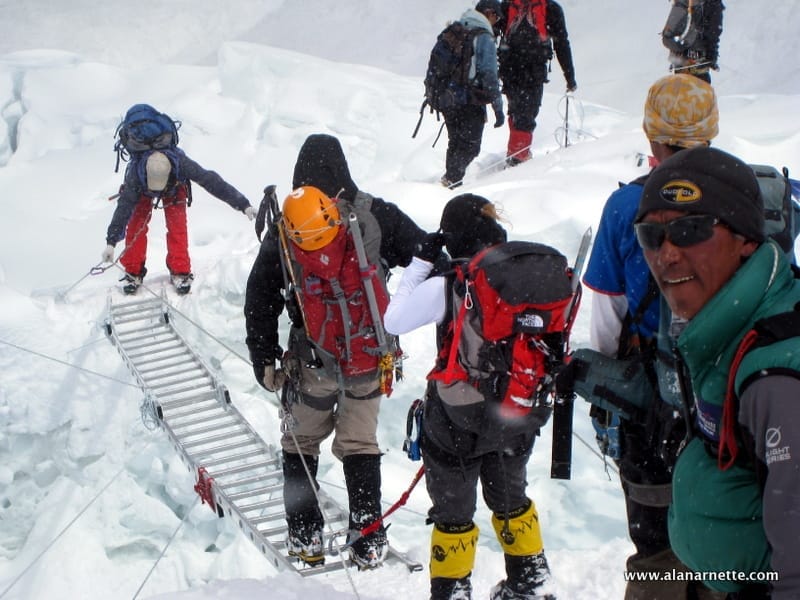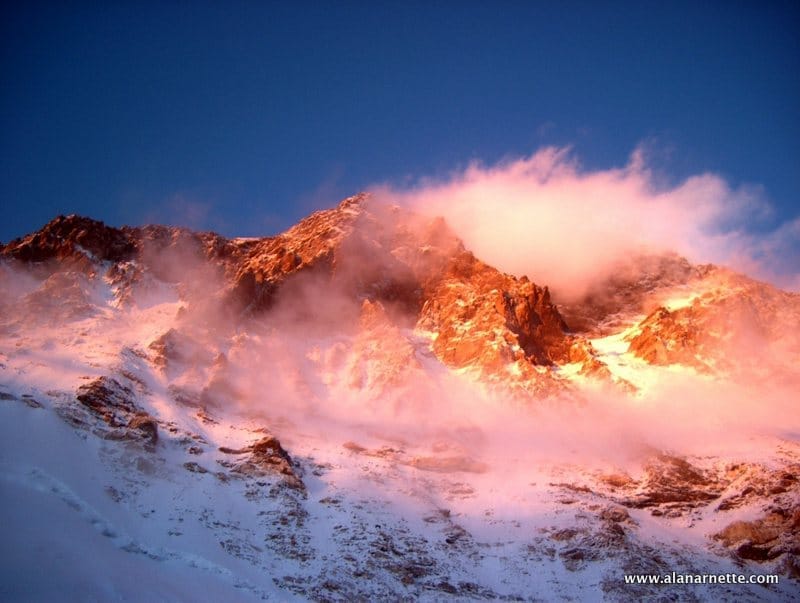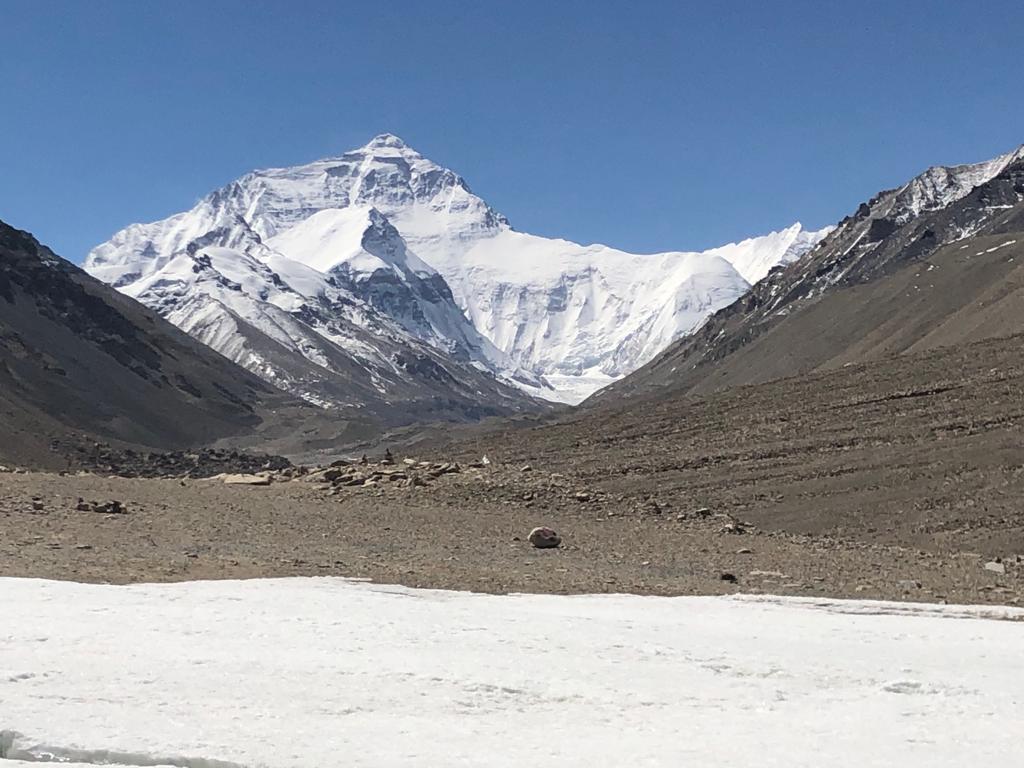As we near the end of January, climbers across the globe are continuing to train, finalize gear and preparing to say goodby to loved ones.
A few months ago, I posted what I tongue-in-cheek called a “personal letter” to 2017 Everest climbers with the message – don’t go! The main point I was making was that in modern times, post 2000, lack of experience played a large role in the deaths of some climbers.
I went as far as to list some questions that was designed to make people think about what they thought they knew about climbing Everest. A couple of days ago, I recieved a comment asking for my view on the answers to those questions so here goes. Of course these are my opinion as every question in this world has multiple answers these days 🙂 🙂 .
Q: What is the highest altitude you have ever reached?
Alan’s view: depends on the person. If not above 8000m, I don’t think someone should attempt Everest – highly controversial and few operators use this qualification.
Q: When do you use a tent parachute stake on Everest? (trick question!)
Alan’s view: rarely if ever. A parachute stake is used in deep, soft snow such as is usually found on Denali. Everest usually has hard packed ice so stakes are used.
Q: What do you use to replace a lost jumar at the Balcony?
Alan’s view: bring a spare or you can rig a system using a tribloc and carabiners.
Q: How long will a 4 liter cylinder of oxygen last running at 2 liters per minute (lpm) or 4 lpm?
Alan’s view: Climbers usually run the flow at 2 or 3 liters per minute meaning a 3 liter bottle will last about 6 hours, 3 hours at 4 lpm. Most climbers will need at least 4 bottles or maybe 19 hours of supplemental oxygen because sometime they will run the flow at 3 or 4 lpm.
Q Is it ever acceptable to turn your oxygen down or even off while climbing Everest, especially near the summit?
Alan’s view: sure, it is advised to save Os since you really need it when you are moving. If stuck in a long queue or line, turning it down to 1 lpm or even 0.5 lpm saves a lot of Os that may be needed later – especially if you have been struck for a couple of hours. BUT – this should be a joint decision with your guide and Sherpa and not done without informing them.
Q: How long do you wait after a large snowstorm to begin climbing again?
Alan’s view: the rule of thumb is to give a large load of new snow a minimum of 24 hours with a bright sunny day to settle in order to lessen avalanche chances – 48 is better. In general, on the normal routes on Everest there have been few avalanches on the route itself. There have been avalanches off the adjacent slopes, Everest West Shoulder and Nuptse, that have killed many people.
Q: Will eating the same food as Sherpas increase your chances of summiting?
Alan’s view: Climbers need to eat what they can digest and this should have been determined on other high altitude climbs, not for the first time on Everest. The staple of a Sherpa’s diet is Dal bhat, white rice accompanied by curried vegetables and a bowl of a lentil-based juice. Many westerners love it but it can get boring after a few days for some. Also, it has a small amount of protein that I find is critical to avoid losing weight. Before leaving camp in early morning, the Sherpas will eat a filling meal called tsampa which has a porridge like consistency and is made from roasted barley flour mixed with tea, beer, or water and formed into thick dough-like balls. I have found that few westerners can eat like a Sherpa at 3:00 AM! Most will eat eggs and toast before heading up the mountain.
Q: How do you keep your hands warm if you lose a glove at 7500 meters?
Alan’s view: bring a spare set of gloves and mittens plus chemical hand warmers. Bare skin can freeze in minutes at those altitude with harsh winds and freezing temperatures.
Q: How much larger or smaller should your mountaineering boot be compared to your street shoe size? (another trick question)
Alan’s view: The rule of thumb is to buy your high altitude boots at least one size larger than your street size. Feet swell at altitude – a key point. But the best technique is to buy your boots from a local store, not online, and try them on with the exact sock configuration (thick, thin, combinations) you will use on Everest. Then wear them on a local hike – at home – and go back to your expert store for any adjustments such as widening the toe box. If you don’t have a local store that sells high altitude boots then buy from an online store where you can exchange wrong sizes easily.
True/False: Having a SPOT or Delorme InReach with the SOS feature will ensure that a rescue team will reach you in case of a crisis anywhere in Nepal.
Alan’s view: While this is a comforting selling point for those at home, the reality is those devices are monitored by organizations halfway across the globe. Yes, they may be able to contact your rescue service (Global Rescue, Travelex, etc.) but in the end you will be rescued by someone within hours of you, not across the world so a reliable multichannel radio that you know how to use and are 100% certain that the frequency you use is monitored is your best protection – and better yet climb with someone you trust and has the skills to help in case of an emergency, this most likely means going with a proven, experienced guide service.
True/False: Sleeping in an altitude tent replaces the need to do acclimatization rotations.
Alan’s view: The common wisdom is that altitude tents will acclimatize you to about 17,000 feet. Everest is 29,035 feet so you will still need to do acclimatization rotations but maybe not as many. But everyone reacts differently to these situations so arriving late or buying your return plane ticket based on “pre-acclimatizing” is ambitious – imho.
True/False: Acclimatizing on smaller nearby peaks substitutes the need to sleep at high altitudes on Everest before making your summit bid.
Alan’s view: It is common these days to use the 20,000 foot trekking peak Lobuche as an acclimatization peak in order to eliminate one or maybe two rotations thru the Khumbu Icefall. But even with this strategy, teams usually try to get to 21,000 feet or 23,000 feet before the summit bid on either side.
True/False: Anyone in ‘good shape’ can summit Everest without much difficulty.
Alan’s view: This is a popular marketing statement but is naive and dangerous in my humble opinion. The altitude on Everest is what makes it so dangerous. Being in the best shape of your life is probably not Everest shape and altitude sickness can strike anyone at anytime – even those long time professional climbers who have never gotten altitude related illness before. So, yes, being in great shape is necessary but not sufficient to climb Everest. And no-one, no-one, summits Mt. Everest without some discomfort – even Sherpas.
True/False: Being so tired you can barely move is normal on Everest or at any extreme altitude.
Alan’s view: Reaching a high level of fatigue is quite common. This is why having experience on a previous 8000m climb is critical to understand if you are just hurting or really hurt. But if someone is so fatigued that they cannot move without assistance it is a clear sign to descend immediately on a high flow of supplemental oxygen – with assistance from healthy climbers. Never ever climb alone on Everest, or any high altitude mountain.
True/False: Summiting Kilimanjaro, Mont Blanc, Island Peak, Lungser Kangri or Mentok 2 will fully prepare me for Everest.
Alan’s view: These peaks will give someone a lot of mountaineering experience but are not sufficient to attempt Everest, again in my humble opinion. I strongly believe you need to have personal experience above 26,246 feet or 8,000 meters to understand how your body reacts at that altitude. Some people simply shut down and cannot function, others do well, everyone struggles to some extent. Those peaks listed in the question will help you understand some basics of climbing on high, somewhat steep mountains but are in a different league than a 8,000 meter climb.
and finally
True/False: There is no safety difference between climbing with a service that charges $30,000 and one that charges $60,000 as long as you have a Sherpa with you that has summited before.
Alan’s view: In 2017, there are several companies that will take on an Everest climber for under $35,000. There are real differences and safety could be a factor in terms of Sherpa experience (some have never climbed Everest), radio communications, amount of supplemental oxygen, quality of and sufficient food to maintain a healthy weight, group gear such as tents, stoves and fuel at high altitude, etc. The more you pay, with exceptions, the more support you will have from qualified Sherpas and/or western guides, spare equipment and oxygen, resources to assist in case of an emergency and experience on the the mountain. All for this cost real money. Research your guide service and get recent references from a climber who has a similar profile you yours (age, experience, etc.) before sending in your money.
OK, so those are my views and I sure others can add or disagree. All good!
2017 is shaping up to be a record year on Everest. I predict over 600 summits on the South side and well over 200 on the North totaling over 800 smashing the record set in 2013 with 658 total summits from both sides. In 2016, 641 climbers made the summit from both sides.
We may see some interesting climbs. For example, Uli Steck is supposed to attempt a Everest/Lhotse traverse.
Also, the Indians are remeasuring Everest with the approval from Nepal to see what difference the 2015 earthquake had on the height.
Finally the current winter attempt on Everest continues right now with Alex Txikon reaching about 7800 meters before returning to base camp awaiting a good weather window. It looks like he has a great chance based on his performance thus far of summiting in the next two weeks.
Wishing everyone a safe season.
Climb On!
Alan
Memories are Everything





3 thoughts on “Everest 2017 Gets Closer – A Q&A”
Alan: How much of a difference does “where you live” affect your chances of reaching the summit? Most people in the US live near sea level.
It all comes down to your training. Those who live in Colorado for example at 5,000 might have a slight advantage but still must acclimatize the same as someone who lives at sea level. BY training diligently for a year in advance, most people can be in Everest Shape, which is significantly better than most people’s “best shape of my life” status.
Another interesting read Alan. I won’t be there but I will keep a sharp eye on the climbs looking to see if your suggestions are being adhered to.
Good luck Mathieu, hope all goes well for a successful and safe trip. Cheers Kate
Comments are closed.